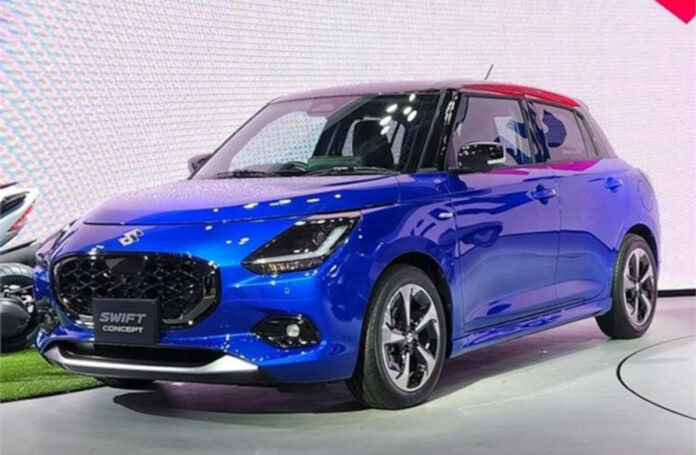All-new fourth-generation Suzuki Swift
The unveiling of the fourth-generation Swift at the Tokyo Motor Show 2023 marks a significant step for Suzuki, particularly in its strategic market – India, where the vehicle will be sold as the new Maruti Suzuki Swift. Here’s a deeper dive into what these changes and continuities mean for consumers and the brand’s strategy overall.
- Styling and Design Evolution: The decision to maintain the distinctive ‘Swift’ design while introducing sharper, more modern elements like the flatter nose, angular headlamps, and reimagined grille could be Suzuki’s attempt to blend familiarity with innovation. This approach might be aimed at retaining Swift’s existing customer base while attracting new buyers who are looking for modern aesthetics. The sportier look aligns with global trends emphasizing dynamic, aggressive automotive styling to appeal to a younger demographic.
- ADAS Features: The inclusion of Advanced Driver-Assistance Systems (ADAS) in the model showcased in Tokyo indicates Suzuki’s alignment with the global push towards enhanced vehicle safety and semi-autonomous driving. However, the uncertainty surrounding these features in the Indian variant might be attributed to factors like cost sensitivity and the existing infrastructure in India, which may not yet fully support ADAS functionality. Introducing such features requires a balancing act between keeping the vehicles affordable (a significant factor in the Indian market) and offering advanced technology.


Hybrid Powertrain
- Hybrid Badging and Powertrain Strategy: The presence of ‘Hybrid’ badging signals Suzuki’s acknowledgement of the global shift towards electric and hybrid vehicles. However, the continuation of a pure petrol powertrain for the Indian market suggests a strategic decision based on the current Indian automotive market’s preferences and infrastructure readiness for hybrid/electric vehicles. It seems a calculated move to avoid alienating the existing customer base accustomed to petrol engines while the market gradually warms up to alternative fuel technologies.
- Interior Familiarity: The interior design shares elements with other vehicles in the Suzuki lineup, like the Baleno and the Fronx. This strategy might be due to cost-saving reasons, allowing Suzuki to streamline production and maintain cost efficiency. For the consumer, it provides a sense of consistency across the brand’s range, potentially improving user experience due to familiarity with the brand’s interface and controls.
Maruti Suzuki
- Market Strategy and Expectations: Overall, Suzuki’s strategy appears to hinge on balancing global trends with local market realities. While they are introducing the Swift with features expected in contemporary automotive design and technology, they are also mindful of the specific preferences, conditions, and constraints of the Indian market. Customers would expect competitive pricing, and considering the significance of the Swift in Maruti Suzuki’s portfolio in India, the brand would likely ensure that this model remains accessible to a broad segment of buyers.
Pros of the new 2023 Suzuki Swift:
- Sharper new design with a more aggressive front-end
- Potential availability of ADAS features
- Potential availability of a hybrid powertrain
- Familiar interior with shared components from the Baleno and Fronx
Cons of the new 2023 Suzuki Swift:
- Availability of ADAS features and hybrid powertrain in India is unconfirmed
- Interior may be perceived as too familiar by some buyers
- Performance and fuel efficiency of the hybrid powertrain are unknown
New design
As more details about the new Swift emerge, potential buyers and industry observers alike will be keen to see how Suzuki navigates these various factors in its final production model and overall marketing strategy. The approach taken with Swift will likely have implications for Suzuki’s brand image, market positioning, and environmental strategy in India and potentially influence broader trends in the region’s automotive sector.
Conclusion
The unveiling of the fourth-generation Suzuki Swift represents a strategic blend of innovation, consumer preference, and market insight. By integrating modern design cues and potential ADAS features, Suzuki aligns itself with global automotive trends, signaling its commitment to innovation and safety. Yet, the company exhibits a keen understanding of the Indian market’s unique characteristics through its powertrain and feature choices, particularly the continuation of the petrol engine variant and the cautious approach towards advanced driving systems.





































